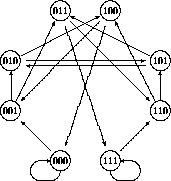Three stage binary matrix

Figure 10: Generic (2,3/2) de Bruijn diagram.
By the third stage the staircase is fully evident; each step contains k 1's, likewise there are k staircases:
0.30em

The minimal equation is readily determined to be ![]() , and as before the Jordan normal form prevails.
, and as before the Jordan normal form prevails.
There are two interesting factorizations, both of which are quite general: ![]() according to
according to
0.30em

and ![]() according to 0.30em
according to 0.30em

Several relationships among these matrices are evident; for example:

wherein I is the unit matrix. The factors satisfy several identities, of which the most useful are:
![]()
![]()
P and Q are noncommuting permutation matrices; nevertheless the noncommutative binomial theorem can still be used to evaluate powers of D. Whatever scheme is used, the essential observation is that powers of D exhibit broader steps and more numerous ladders until the matrix is solidly filled with 1's; from then on successive powers merely differ by the factor k.
Harold V. McIntosh
E-mail:mcintosh@servidor.unam.mx